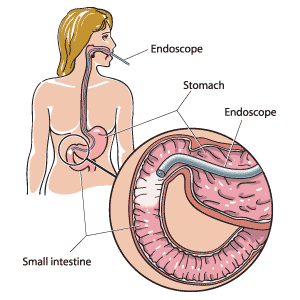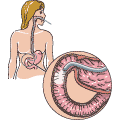Description of the test
An upper gastrointestinal (UGI) endoscopy lets your doctor examine your esophagus, stomach, and first portion of the duodenum (small intestine) through a long, thin, and flexible tool (known as an endoscope) with a camera and light on the end.
By looking through the endoscope, your doctor can check for ulcers, tumours, infections, inflammation, or bleeding in your upper digestive system.
How often should the test be performed?
Your doctor will decide when and how frequently this test is required.
Why is this test performed?
UGI endoscopy evaluates problems related to the esophagus (the passage leading to the stomach), stomach, or duodenum such as upper abdominal pain, difficulty swallowing, bleeding, nausea, or vomiting.
UGI endoscopy has several advantages over X-rays. It allows your doctor to see inflammation or lesions more clearly than X-rays. It also allows your doctor to obtain small pieces of tissue (biopsy), or obtain some cells with a fine brush (cytology), for examination under a microscope. Finally, your doctor can use accessory instruments to treat certain conditions during the endoscopy, such as opening constrictions or blockages, removing polyps, retrieving foreign objects, or treating gastrointestinal bleeding locally.
Are there any risks and precautions?
Although endoscopy is generally considered safe when performed by a qualified professional, it does have some risk of side effects or complications. These include a temporary sore throat, or, very rarely, a tear in the esophagus lining. If such a tear occurs, you will be admitted to the hospital and fed by a tube until you have healed. In some cases, surgery may be needed to be repair the tear. If you have a biopsy during your endoscopy, there is a possibility of bleeding. There is also a rare occurrence of having a reaction to the sedative.
If you are concerned about any symptoms following this procedure, speak to your doctor.
Take the time to be sure you understand all the risks of complications, side effects, as well as any precautions you or your doctor can take to avoid them. Be sure your doctor understands all your concerns.
What happens during the test?
The test is usually performed by a general surgeon, a gastroenterologist, or an internist.
During UGI endoscopy, while you are lying on your side, your doctor will gently insert the endoscope through your mouth. The endoscope is a flexible tool and can be directed around the many bends of the upper intestinal tract.
You may be given a gargle, liquid spray, or lozenge to help relax and numb your throat so that you don't gag as the endoscope is moved down your throat. You will also be given an injection of a sedative to help you relax and to relieve some of your discomfort during the procedure. Being sedated often means you do not remember the procedure being done, although this is not always the case. If you prefer, the endoscopy can be performed without any sedation.
After the tip of the endoscope is in your mouth, you might be asked to swallow several times, to help advance the instrument into your esophagus and stomach. Keep in mind that the endoscope is not thicker than many foods you swallow, and it won't interfere with your breathing. Air may be pumped into the endoscope in order to inflate your digestive tract so that it's easier to see inside.
As the endoscope travels down your esophagus, your doctor looks through an eyepiece or watches a video monitor to look at the walls of your esophagus, stomach, and duodenum. In some clinics, pictures of your upper digestive tract can be taken for your medical records. Using special instruments passed through the endoscope, samples (biopsies) may be taken from your upper digestive tract to be looked at under the microscope. This is painless and can help determine what is causing your symptoms. It is common to take biopsies from the stomach to look for an infection caused by the bacteria called Helicobacter pylori, which can cause ulcers.
You might feel nauseous or bloated, or feel pain or cramps in your stomach. If you experience severe pain, don't try to talk. Most likely, your doctor will have prearranged a special signal with you to indicate this.
After the pictures have been taken, and after your doctor has thoroughly looked at your digestive system, the endoscope will be withdrawn.
The entire procedure usually takes about 30 minutes.
If you were sedated, you will need to rest in the endoscopy facility for 1 to 2 hours until the medication wears off. You must not drive or operate machinery for 24 hours. Therefore, you will need someone to drive you home or accompany you on public transportation.
How should I prepare for this test?
Before having this procedure, discuss the advantages, disadvantages, or long-term risks and consequences associated with the procedure with your doctor. Be sure you fully understand what will happen and are comfortable with your doctor's answers to your questions.
Your doctor will ask you not to eat or drink for at least 4 to 8 hours before the test. This is necessary to ensure the endoscopy is a thorough and safe procedure.
Tell your doctor or prescriber about all prescription, over-the-counter (non-prescription), and herbal medications that you are taking. Also tell them about any medication allergies and medical conditions that you may have.
Also tell your doctor if you are pregnant or suspect you might be pregnant.
Your doctor might ask you to stop taking some medications. For example, you may be ask to stop taking blood-thinning medications for a week before the test, and you may be asked to stop acid-reducing medications a few weeks before the procedure. Ask your doctor or pharmacist whether you need to stop taking any of your medications before the test.
Arrange for someone to drive you home from the hospital.
What can I expect after the test?
You will likely feel some or all of these normal side effects after the test:
- sleepiness or a dry mouth for several hours (this is due to the pain-relieving or sedative medication)
- belching
- a feeling of being bloated
- a mild sore throat for a few days (sucking lozenges or using warm salt water gargles can help ease these symptoms)
- bloody saliva
If you experience any of the following side effects or complications, seek medical help immediately:
- extreme difficulty in swallowing
- vomit with blood, or blood in your stools
- shortness of breath
- increasing chest or stomach pain
- high fever
- chest pain
- difficulty breathing
Results
Your doctor will likely explain the results in the recovery room. If you are still sedated, the results may be explained when you are more awake. The results from biopsies or cytology may take several days and may be explained to you when they are available.
The results of one test, for the bacterium Helicobacter pylori, may be available before you leave the recovery room, although this test is most accurate after 24 hours.
All material copyright MediResource Inc. 1996 – 2025. Terms and conditions of use. The contents herein are for informational purposes only. Always seek the advice of your physician or other qualified health provider with any questions you may have regarding a medical condition. Source: www.medbroadcast.com/procedure/getprocedure/Upper-GI-Endoscopy



